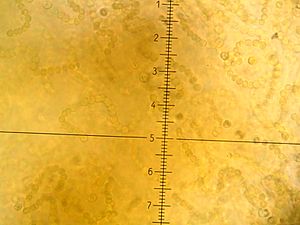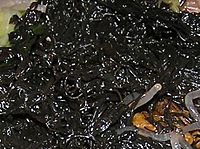Fat choy facts for kids
Quick facts for kids Fat choy |
|
|---|---|
 |
|
| Nostoc flagelliforme under a microscope | |
| Scientific classification | |
| Genus: |
Nostoc
|
| Species: |
flagelliforme
|
| Synonyms | |
| Fat choy | |||||||||||||||
|---|---|---|---|---|---|---|---|---|---|---|---|---|---|---|---|
 |
|||||||||||||||
| Traditional Chinese | 髮菜 | ||||||||||||||
| Simplified Chinese | 发菜 | ||||||||||||||
| Literal meaning | "hair vegetable" | ||||||||||||||
|
|||||||||||||||
| Alternative Chinese name | |||||||||||||||
| Traditional Chinese | 頭毛菜 | ||||||||||||||
|
|||||||||||||||
Fat choy (simplified Chinese: 发菜; traditional Chinese: 髮菜; Mandarin Pinyin: fàcài; Jyutping: faat³ coi³) is a special type of cyanobacterium. This is a tiny living thing that can make its own food using sunlight, much like plants do. Its scientific name is Nostoc flagelliforme.
People in Chinese and Vietnamese cultures use fat choy as a vegetable. When it's dried, it looks like thin black hair. This is why its name in Chinese means "hair vegetable." When you soak it in water, fat choy becomes soft and feels like very fine noodles.
Where Does Fat Choy Grow?
Fat choy grows naturally on the ground in dry places. You can find it in the Gobi Desert and on the Qinghai Plateau. These areas are often very dry and windy.
However, too much harvesting of fat choy has caused problems. In places like the Mongolian steppes, taking too much fat choy has led to erosion (when soil is washed or blown away) and desertification (when land turns into desert). Because of this, the Chinese government has put limits on how much fat choy can be collected. This has made real fat choy more expensive.
Sometimes, you might find fake fat choy being sold. This fake version is often made from starchy materials with added colors. Real fat choy is dark green, but the fake kind looks black.
Fat Choy in Chinese Culture
Fat choy is very popular in Chinese culture, especially during Chinese New Year. This is because its name in Cantonese sounds similar to a phrase meaning "struck it rich." For example, the common New Year greeting "Gung1 hei2 faat3 coi4" (恭喜發財) means "wishing you prosperity."
Because of this lucky sound, fat choy is a favorite ingredient for the reunion dinner during Chinese New Year. It is often used as an alternative to cellophane noodles. You'll find it most often in Cantonese cuisine and in Buddhist cuisine. Sometimes, it's also added to hot pot dishes.
Fat Choy in Vietnamese Culture
Fat choy is also used in Vietnamese cuisine. In Vietnamese, it is called tóc tiên or tóc thiêng. These names literally mean "angel's hair."

